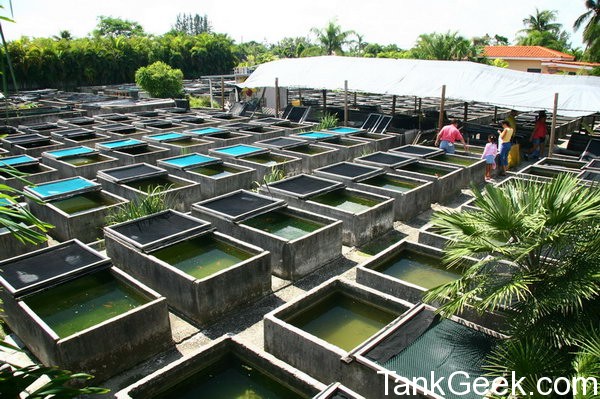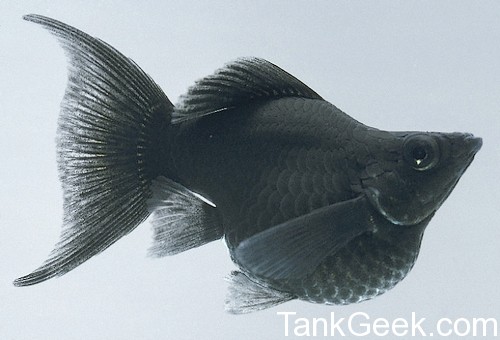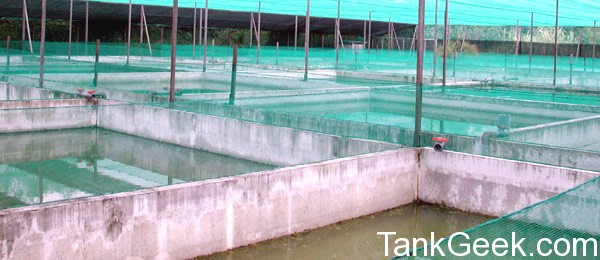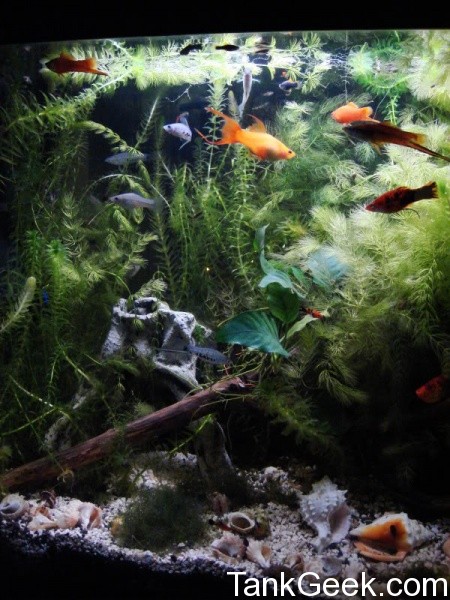In many older books and magazines you’ll read how livebearers like Endler’s Livebearers and Guppies are great for beginners because they’re hardy. This was once true, however now that we are many generations away from wild stock, some of them have become quite weak. Unfortunately, most livebearers are now mass produced. As we all know, when things go into mass production, the quality will decline. I hope to offer some tips to help you be successful with livebearers in spite of the new challenges.
First, lets understand how a majority of livebearers are bred. For economic reasons, most livebearers are bred in climates where it stays warm even through the winter. Florida, Thailand, Hawaii are all popular spots for people to have a fish farm. With free heat, the next thing that is needed is a pond to breed the livebearers in. Simply place a significant quantity of livebearers in a very large pond. Then harvest them as they breed. This process makes it very easy to produce a very large amount of livebearers with much less work than aquariums.

There are several unfortunate consequences to these systems though. The first is constant inbreeding between the livestock. With no one to make sure siblings and children don’t breed with one another, genetics defects can run wild. Many fish farms now harvest the fish from the ponds and then select quality specimens from sorting tanks in a warehouse. Unfortunately, even though they look acceptable, they carry the weakened genes of their parents. To illustrate the point, all “potbellied” variety of platies, and mollies are genetic deformities that have been commercialized and become popular in the trade. These were an accident from downbreeding.

The second problem with the pond style breeding is the introduction of parasites. While the farmers try their best to setup nets and keep pests out of their farms, the fish are exposed to outside influence such as bird parasites. This can have a devastating effect on populations of fish. Fish farms are quarantining the fish for a few days before shipping them out now to watch for parasites. However, if the fish isn’t stressed, they will be able to keep the parasite dormant. It is when the fish becomes stressed during shipping that the parasite is able to grab hold.

The third problem is that many of the ponds are constructed out of concrete. This leaches chemicals into the water that raise the pH and Hardness. While this isn’t necessarily a bad thing on it’s own, uninformed stores and hobbyists are walking into a trap. The fish are coming from a high pH and hard water to local water tap conditions normally. This can put the fish into osmotic shock. Which can kill the fish in a few days or leave it very weakened for underlying conditions to finish it off.
Now that we know how the livebearers we wish to keep are bred, what can we do to combat this? One option is to buy locally bred fish. Even if their stock came from a fish farm, the fry will at least avoid osmotic shock from the huge change in water parameters.
Another option is to acquire wild livestock. These will be much more genetically pure. They could still have parasites or go through osmotic shock though. Also, you may want to consider if the species is endangered in the wild and what that may mean to you. Some aquarists intentionally breed wild, endangered fish to up the populations while others avoid them in hopes of keeping more in the wild.
The last option is what most people will eventually choose. Setup your aquarium closer to the breeder’s water parameters.
This was actually done by accident at first. Mollies were one of the first fish to be severely mass produced and hybridized to get all the great colors we have today. As a result, those mollies didn’t live very long. After quickly searching for information, breeders saw that mollies could live in brackish water. Many stores and hobbyists soon added aquarium salt to their tanks to make their tanks brackish. Miraculously, the mollies now did much better! We thought we figured it out, until people started to point out that aquarium salt doesn’t make water brackish. Marine salt is needed to make water brackish. Aquarium salt does however make your water harder, which lead to better survival rates.
The battle plan to keep healthy livebearers coming from a fish farm starts with setting up your aquarium for high pH and hard water. Then find out what day your local fish store receives fish. Acquire your fish ideally before they go into their water. Take them home and quarantine them in your high pH and hard water. They should thrive once they’re done acclimating. You can then, every so slowly, bring them down to the pH of your tap water over the course of months. Eventually you’ll have fry and they’ll have never known anything other than your tap water. You can then supply your fellow hobbyists with a more stable livebearer.
The trick to the common day livebearer is to minimize stress so that our super colored, extra long finned, genetically down bred fish don’t have to test their immune system. Each new strain of livebearer brings its beauty and deformities with it.
I hope you get a tank ready and give livebearers another chance. They are my favorite type of fish to work with. Once they’ve been stabilized they’re good for many generations.





First, lets understand how a majority of livebearers are bred. For economic reasons, most livebearers are bred in climates where it stays warm even through the winter. Florida, Thailand, Hawaii are all popular spots for people to have a fish farm. With free heat, the next thing that is needed is a pond to breed the livebearers in. Simply place a significant quantity of livebearers in a very large pond. Then harvest them as they breed. This process makes it very easy to produce a very large amount of livebearers with much less work than aquariums.

There are several unfortunate consequences to these systems though. The first is constant inbreeding between the livestock. With no one to make sure siblings and children don’t breed with one another, genetics defects can run wild. Many fish farms now harvest the fish from the ponds and then select quality specimens from sorting tanks in a warehouse. Unfortunately, even though they look acceptable, they carry the weakened genes of their parents. To illustrate the point, all “potbellied” variety of platies, and mollies are genetic deformities that have been commercialized and become popular in the trade. These were an accident from downbreeding.

The second problem with the pond style breeding is the introduction of parasites. While the farmers try their best to setup nets and keep pests out of their farms, the fish are exposed to outside influence such as bird parasites. This can have a devastating effect on populations of fish. Fish farms are quarantining the fish for a few days before shipping them out now to watch for parasites. However, if the fish isn’t stressed, they will be able to keep the parasite dormant. It is when the fish becomes stressed during shipping that the parasite is able to grab hold.

The third problem is that many of the ponds are constructed out of concrete. This leaches chemicals into the water that raise the pH and Hardness. While this isn’t necessarily a bad thing on it’s own, uninformed stores and hobbyists are walking into a trap. The fish are coming from a high pH and hard water to local water tap conditions normally. This can put the fish into osmotic shock. Which can kill the fish in a few days or leave it very weakened for underlying conditions to finish it off.
Now that we know how the livebearers we wish to keep are bred, what can we do to combat this? One option is to buy locally bred fish. Even if their stock came from a fish farm, the fry will at least avoid osmotic shock from the huge change in water parameters.
Another option is to acquire wild livestock. These will be much more genetically pure. They could still have parasites or go through osmotic shock though. Also, you may want to consider if the species is endangered in the wild and what that may mean to you. Some aquarists intentionally breed wild, endangered fish to up the populations while others avoid them in hopes of keeping more in the wild.
The last option is what most people will eventually choose. Setup your aquarium closer to the breeder’s water parameters.
This was actually done by accident at first. Mollies were one of the first fish to be severely mass produced and hybridized to get all the great colors we have today. As a result, those mollies didn’t live very long. After quickly searching for information, breeders saw that mollies could live in brackish water. Many stores and hobbyists soon added aquarium salt to their tanks to make their tanks brackish. Miraculously, the mollies now did much better! We thought we figured it out, until people started to point out that aquarium salt doesn’t make water brackish. Marine salt is needed to make water brackish. Aquarium salt does however make your water harder, which lead to better survival rates.
The battle plan to keep healthy livebearers coming from a fish farm starts with setting up your aquarium for high pH and hard water. Then find out what day your local fish store receives fish. Acquire your fish ideally before they go into their water. Take them home and quarantine them in your high pH and hard water. They should thrive once they’re done acclimating. You can then, every so slowly, bring them down to the pH of your tap water over the course of months. Eventually you’ll have fry and they’ll have never known anything other than your tap water. You can then supply your fellow hobbyists with a more stable livebearer.
The trick to the common day livebearer is to minimize stress so that our super colored, extra long finned, genetically down bred fish don’t have to test their immune system. Each new strain of livebearer brings its beauty and deformities with it.
I hope you get a tank ready and give livebearers another chance. They are my favorite type of fish to work with. Once they’ve been stabilized they’re good for many generations.







